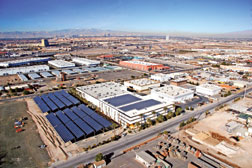 Barnhart Crane
|
 TWC Construction Inc.
|
 Power Engineers Inc. Wind energy (top) dominates the growing renewables sector, but solar installations (middle) are multiplying and geothermal plants (bottom) are reaching new territory.
|
In the game of Monopoly, the Electric Co. is a safe, dull play; it is priced low and generates modest income. In the real world, though, the electricity business is rougher than a rodeo bull ride: Governments have joined environmental activists in challenging permit applications for new coal-fired power plants, prices for coal and natural gas are volatile as never before, and states are requiring utilities to meet growing proportions of electricity demand with renewable energy.
The unsettled action has been escalated further by Congress’ piecemeal extension of renewable-energy investment- and production-tax credits, increasing the risk in long-term investment decisions. Developers insist that renewable-energy projects will die if the credits expire, but investor-owned utilities, driven by renewable portfolio standards and with recourse to cost recovery, say they will build even without the credits.
The most active renewables today—wind, solar and geothermal—make up just 10% of the renewables market. Wind-energy development has grown rapidly in the last decade, and solar and geothermal energy also have benefited from supportive government policies in recent years. One sign of renewable energy’s new vitality is the swelling flow of venture capital to the market.
|
Wind energy is the fastest-growing renewable sector because it is a maturing technology with potential for widespread application. Wind turbines are popping up everywhere. U.S. wind capacity last year grew 5,244 MW, an increase of 45%. “That’s in an environment where coal plants are having a tough time getting approved,” says Thomas S. Key, Knoxville, Tenn.-based technical lead for renewables and hydropower at the Electric Power Research Institute.
The U.S. is the second-largest wind-energy market and is posted to overtake Germany by the end of next year, according to the Brussels, Belgium-based Global Wind Energy Council.
Wind energy has led the growth in renewable energy because it is the easiest technology to use, Key says. But sources agree that renewable energy is a policy-driven business. The most significant policies in the U.S. have been renewables-portfolio standards (RPS) and investment- and production-tax credits.
| Renewable-Energy Production | ||||||
| Year | Geothermal | Solar/PV | Wind | |||
| Installed MW | Generation* | Installed MW | Generation* | Installed MW | Generation* | |
| 2003 | 2,133 | 14,424,231 | 397 | 534,001 | 5,995 | 11,187,466 |
| 2004 | 2,152 | 14,810,975 | 398 | 575,155 | 6,456 | 14,143,741 |
| 2005 | 2,285 | 14,691,745 | 411 | 550,294 | 8,706 | 17,810,549 |
| 2006 | 2,274 | 14,568,029 | 411 | 507,706 | 11,329 | 26,589,137 |
| 2007 | 2,294 | 14,838,636 | 498 | 606,082 | 15,616 | 32,143,244 |
| *Thousand kilowatt-hours Source: Energy Information Administration | ||||||
An RPS essentially is a requirement that retail electricity suppliers meet demand with a set minimum quantity of power from renewable sources. Today, 25 states and the District of Columbia, representing 46% of national retail electricity sales, have set mandatory RPS quotas. Repeated efforts to establish a national RPS have failed.
Solar energy, while growing, is a tiny sliver of the renewable-energy market. In 2004, residential installations generated more than 90% of the power from solar energy, according to the Energy Information Administration. But utility-scale solar plants are now being built, suggesting the potential for substantial further growth.
Utility-scale geothermal powerplants were first built in the 1960s, but the U.S. market has been restricted to a few areas in the West where geothermal energy is relatively accessible. Aided by investment-tax credits in the energy legislation of 2005, the industry has experienced growth in several states where it has not previously.
RPS is a state initiative, but Congress enacted the first production-tax credit in 1992 for wind energy. It has had a bumpy ride, with repeated expirations and renewals, and was extended to geothermal energy developments in the Energy Policy Act of 2005. It is set to expire at the end of 2008. The investment-tax credit, applied to solar energy, also was enacted in EPAct 2005. Subsequently extended, it also is scheduled to expire at the end of the year.
Distance from load centers is a major drag on the development of renewable-energy resources, so long transmission lines must be built to successfully develop them. States increasingly are recognizing this, says a report published in April by Lawrence Berkeley National Laboratory, and they are enacting legislation and other policies to encourage transmission construction.
| + click to enlarge |
 |
RPS has pushed the market, but the production-tax credit has pulled it, says Jack Levi, cofounder of National Wind LLC, Minneapolis, a developer. “The economic justification is what drives things in the long run,” he notes.
But Congress’ fickleness has made the PTC an unreliable engine. The stop-and-go market has made manufacturers reluctant to build capacity for it. “The industry needs a long-term, consistent industry program,” says Larry Stoddard, manager of renewable-energy consulting for Black & Veatch, Kansas City.
Brisk Wind
But the volatility of fossil-fuel prices is making wind competitive. Wind farms cost about $2,000 per installed kilowatt and sell power for 6¢ to 10¢ per kilowatt-hour. “Wind is the most competitive source of producing renewable electricity,” says Gabriel Alonso, chief development officer of Horizon Wind Energy, Houston. “We have more...
 Related Links:
Related Links: 